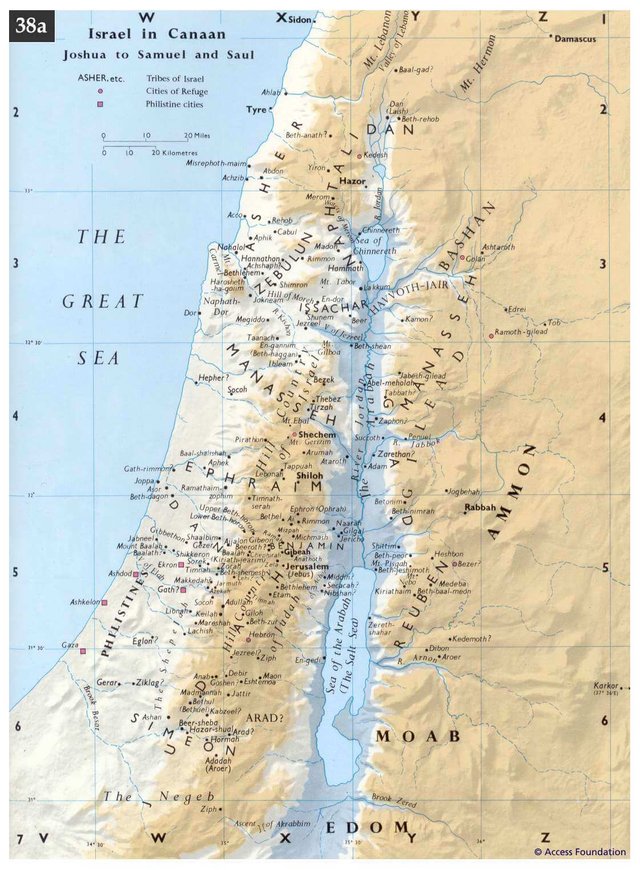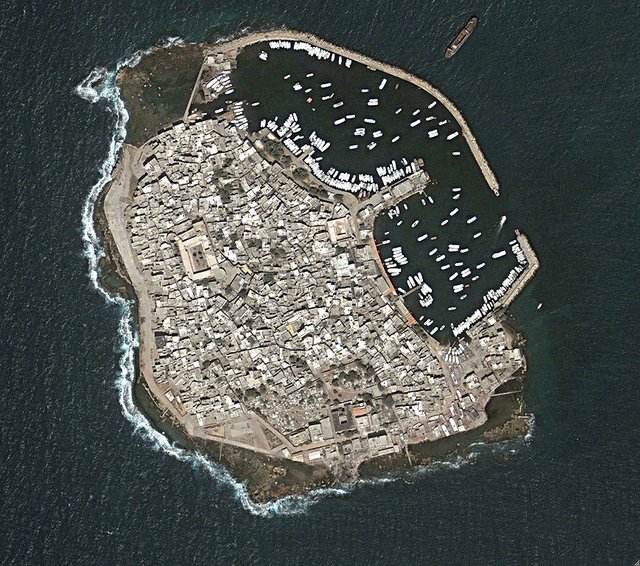
In Joshua 9, we are told of all the kings which were on this side Jordan, in the hills, and in the valleys, and in all the coasts of the great sea over against Lebanon, the Hittite, and the Amorite, the Canaanite, the Perizzite, the Hivite, and the Jebusite. Here we have a list of six nations settled in the Land of Canaan, whose sovereignty was threatened by Joshua’s invasion:
- Hittites
- Amorites
- Canaanites
- Perizzites
- Hivites
- Jebusites
Who were these peoples?
The Hittites of Joshua 9 should not be confused with the Anatolian people whom the archaeologists still designate with this name. In the 19th century, when Akkadian texts referring to Ḫatti and Egyptian texts referring to Kheta were deciphered, it was erroneously concluded that the inhabitants of this mysterious empire on the Anatolian Plateau were the same as the Biblical Hittim, or Hittites. I recently examined this issue in an article on the so-called Hittites in my series on Gunnar Heinsohn and the Short Chronology, so I won’t rehearse the same arguments again.
The Biblical name Hittite was first conferred on the people of Kheta or Ḫatti by the German Egyptologist Heinrich Karl Brugsch. In A History of Egypt under the Pharaohs, he wrote:
We believe we are falling into no error if we persevere in our opinion, which recognises in these people the same Khethites (Hittites) about whom Holy Scripture has so much to tell us, from the days of the patriarch Abraham till the time of the Captivity. (Brugsch 2)
Not everyone agreed that Kheta and Ḫatti_ corresponded to the Biblical Khitti [חתי] (Strong 45) or in the plural Hittim [חתים] (Judges 1:26). The German orientalist Friedrich Max Müller argued that these toponyms ought to be linked to the Biblical Kittim [כתים]. The Kittim came to be associated with the islands of the eastern Mediterranean, including those of the Aegean Sea. In 1 Maccabees 1:1, Alexander the Great is said to have come from the “land of Kittim”.

If we accept, then, that there was no connection between the Hittim of Canaan and the Anatolian empire, then who exactly were the Biblical Hittites?
Elsewhere in the Bible, the Hittites are sometimes referred to as Sons of Heth [בני חת]. In Genesis 10 we are told that Canaan was one of the sons of Noah’s son Ham:
And the sons of Ham; Cush, and Mizraim, and Phut, and Canaan ... And Canaan begat Sidon his first born, and Heth, And the Jebusite, and the Amorite, and the Girgasite, And the Hivite, and the Arkite, and the Sinite, And the Arvadite, and the Zemarite, and the Hamathite: and afterward were the families of the Canaanites spread abroad. And the border of the Canaanites was from Sidon, as thou comest to Gerar, unto Gaza; as thou goest, unto Sodom, and Gomorrah, and Admah, and Zeboim, even unto Lasha. (Genesis 10:6 ... 15-19)

Some of these people were named after one of their principal cities:
Sidon: a Canaanite city in southern Lebanon.
Jebus: according to Judges 19:10, this was a Canaanite name for Jerusalem.
Arqa: a Canaanite city in northern Lebanon.
Sin: according to Jerome, there was a ruined city of this name near Arqa.
Arwad: a Canaanite city on an island off the coast of Syria.
Sumur or Zemar: a Canaanite city on the Syrian coast.
Hamath: a Canaanite city in Syria.
The exceptions are the Hittites, Amorites, Girgashites and Hivites. The Perizzites too are not associated with any particular city. Perhaps these exceptions were also named after cities, but the cities in question have not yet been identified.

The Bible also mentions other Canaanite tribes besides the ones in Genesis 10 and Joshua 9. In Genesis 15, for example, when Yahweh makes a covenant with Abram, he says:
In the same day the Lord made a covenant with Abram, saying, Unto thy seed have I given this land, from the river of Egypt unto the great river, the river Euphrates: The Kenites, and the Kenizzites, and the Kadmonites, And the Hittites, and the Perizzites, and the Rephaims, And the Amorites, and the Canaanites, and the Girgashites, and the Jebusites. (Genesis 15:18-21)
Some of these may have dwelt in Transjordan, between the Jordan and the Euphrates. The Horites too are mentioned in Genesis 14 as dwelling in the vicinity of Mount Seir, the mountainous region to the south of the Dead Sea. The identities of these different peoples are still disputed.
Canaanites and Phoenicians
Several of these cities—eg Sidon, Arwad, Sumur—were Phoenician cities. What exactly was the relationship between the Phoenicians and the Canaanites? The simplest answer to this question is that they were one and the same, Canaanite being their native name for themselves and Phoenician being the Greek name for them. The name Phoenicia is itself of uncertain origin. One popular theory identifies it as an exonym—a foreign name bestowed on this people by the ancient Greeks:
Phoenicia comes from the Greek word, phoinix, meaning “red-purple” and later referred to the people who traded the goods from the area. (Reece 6)
The expensive dye known as Tyrian Purple was a major export of the Phoenicians. Gram for gram, it was more valuable than gold and was largely responsible for the wealth of several Phoenician city states. But I believe that this theory is contradicted by the existence of the ancient toponym Punt, which can be found in Egyptian inscriptions dating back to the 5th Dynasty and may be connected with the Phoenicians.

According to Herodotus, Canaan was not the original home of the Phoenicians:
These people came originally from the so called Red Sea; and as soon as they had penetrated to the Mediterranean and settled in the country where they are today, they took to making long trading voyages. [Translator’s Footnote: Red Sea: the Greeks used this expression for all parts of the southern (our Indian) Ocean. Here the Persian Gulf is meant, and the reference is to (real) ancient influences from Mesopotamia.] (Sélincourt 41)
Is it merely a coincidence that phoinix means red-purple and the Phoenicians once dwelt on the Red Sea? Herodotus’s remarks may be taken to imply that the ancestors of the Phoenicians were the indigenous inhabitants of Lower Mesopotamia, and that they migrated out of that region when the Sumerians (ie Chaldaeans) invaded. Being a seafaring nation and skilled ship builders, the Phoenicians perhaps sailed around Arabia, and first settled in Somalia (Punt). Later they migrated to Egypt, and from there to Canaan, which may also have been known to the Egyptians as Punt:
Various statements in Egyptian literature clearly link Punt to Phoenicia and Palestine. Velikovsky himself noted an official of the 6th Dynasty who casually remarked that he had visited Punt and Byblos eleven times, and in fact no less than three Old Kingdom texts speak of Byblos and Punt in connection with each other. In addition, and this is a point even Lorton has to concede, Punt is always described as being to the east of Egypt, whilst a whole series of documents, Bimson admits, place Punt in the north, and specifically associate the region with known cities in Syria. (Sweeney 37)
As Sweeney also notes, the Romans referred to the Carthaginian Wars as Bella Punica, the Punic (ie Phoenician) wars. Carthage was a Phoenician colony.
My current working hypothesis is the Three Punts Theory, according to which the ancient Egyptians used the toponym Pwnt to refer to three different locations:
Lower Mesopotamia (Sumeria, Chaldaea), the original homeland of the Phoenicians.
The Horn of Africa, where the Phoenicians may have temporarily dwelt.
Canaan, where the Phoenicians finally settled.
Herodotus’ testimony that the Phoenicians only became seafarers after they had settled in Phoenicia suggests that they migrated from Chaldaea to Phoenicia overland—namely, by crossing the Syrian Desert. This would weaken the theory that there ever was a Punt in the Horn of Africa. See Emmet Sweeney’s Empire of Thebes (pp 34 ff) and Charles Ginenthal’s Pillars of the Past (Volume 4, pp 564 ff) for further discussion on the location of Punt.

Were the Israelites Canaanites?
The simple fact is that the Phoenicians and the Canaanites were one and the same, and in fact the Phoenicians referred to themselves as Canaanites:
The name ‛Canaan’ did not entirely drop out of usage in the Iron Age. Throughout the area that we—with the Greek speakers—prefer to call ‛Phoenicia’, the inhabitants in the first millennium BC called themselves ‛Canaanites’. (Drews 48-49)
The Old Testament makes a clear distinction between the Israelites and the Canaanites. But was there one? Ancient Hebrew and Phoenician were closely related languages. They both belonged to the Northwest branch of the Semitic family. In fact, they were so closely related that they are now classified as dialects of Canaanite, one of the three subgroups of Northwest Semitic. The earliest alphabet used by the Israelites, Paleo-Hebrew, was derived from the Phoenician alphabet.
There is, in fact, no compelling reason not to regard the Israelites as a Canaanite nation. They were part of the same Semitic melting pot that also included the Phoenicians, Moabites, Ammonites, Edomites, etc.
And that’s a good place to stop.
References
- Friedrich Karl Brugsch, A History of Egypt under the Pharaohs, Volume 2, John Murray, London (1879)
- Robert Drews, Canaanites and Philistines, Journal for the Study of the Old Testament, Issue 81, pp 39-61, Sheffield Academic Press Limited, University of Sheffield, Sheffield (1998)
- Charles Ginenthal, Pillars of the Past, Volume 4, Ivy Press Books, Forest Hills, NY (2012)
- Katherine Reece, The Phoenicians: Mysterious Sea Peoples, Rourke Publishing LLC, Vero Beach, FL (2004)
- Aubrey de Sélincourt (translator), Herodotus: The Histories, Penguin Books Limited, Harmondsworth, Middlesex (1954)
- Emmet Sweeney, Empire of Thebes, or Ages in Chaos Revisited, Ages in Alignment, Volume 3, Algora Publishing, New York (2006)
Image Credits
- Canaan: © Access Foundation, Fair Use
- Phoenicia (Replica Phoenician Vessel): Copyright Unknown, Fair Use
- Arwad: NASA, Public Domain
- The Discovery of Purple: Theodoor van Thulden (artist), Museo del Prado, Madrid, Public Domain
- Min of the Desert (Replica Egyptian Vessel): Replica of an 18th-Dynasty Sea-Going Vessel, © Cheryl Ward, Fair Use

Nice post keep it up buddy.
Hope you got the 100 STEEM & 1000 TAKI Airdrop, if not get it quickly before the campaign ends.
go to this official taki announcement how to get the airdrop CLICK HERE
Downvoting a post can decrease pending rewards and make it less visible. Common reasons:
Submit